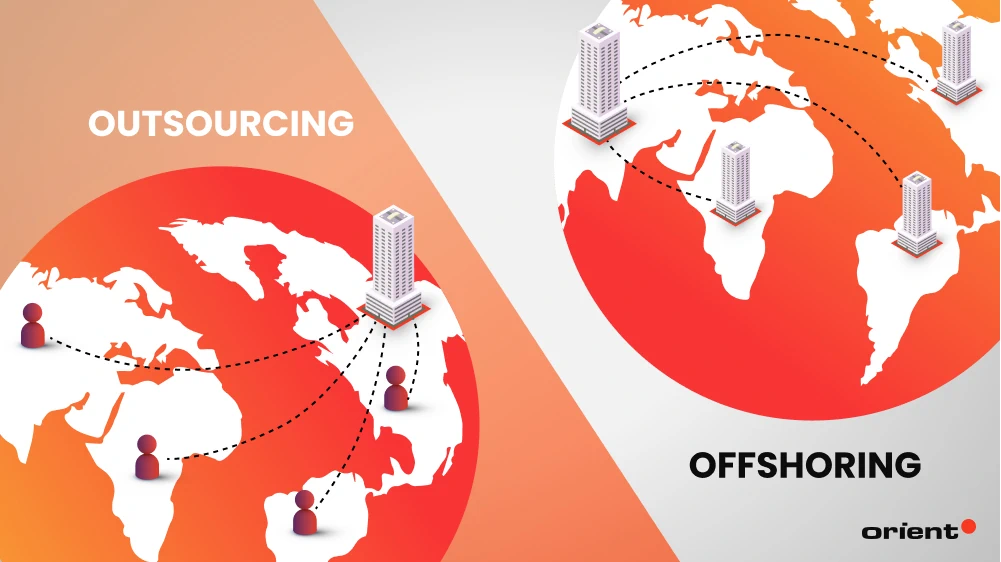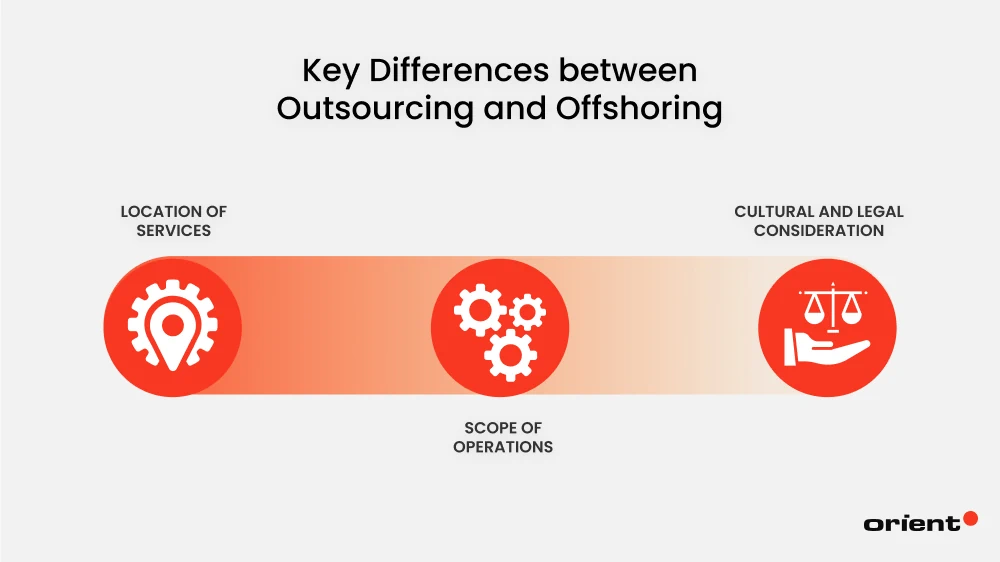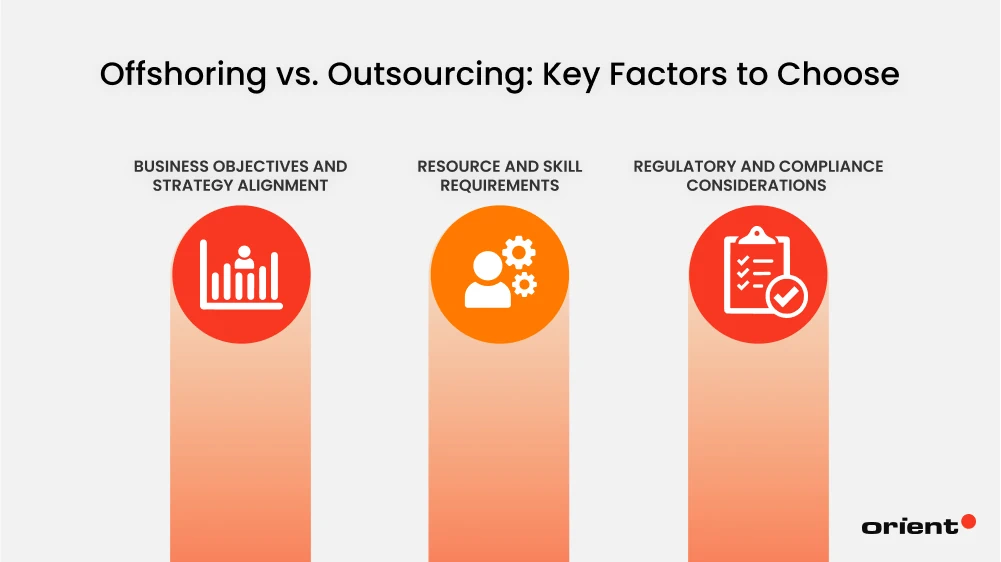
Outsourcing vs. Offshoring: What’s the Real Difference?
Unlock the distinctions in “Outsourcing vs. Offshoring.” Dive into how these strategic approaches differ, their unique benefits, and which suits your business best. Explore our comprehensive guide to stay ahead in the global market!

Content Map
More chaptersIn recent years, Vietnam emerged as one of the most attractive destinations for offshoring business services, scoring high in financial attractiveness and availability of skilled staff. On the other hand, 68% of companies in the US have embraced outsourcing to delegate various services, highlighting its widespread adoption. Major organizations are always on the lookout for improved means and targets to perform their activities with minimal expenses. There are two approaches that have received a lot of attention: outsourcing and offshoring. All these terms are used interchangeably on many occasions. However, they possess different connotations and implications for companies.
Awareness of these differences is especially important in order to make adequate strategic decisions in the sphere of outsourcing vs. offshoring. This article brings out some unique differences between these strategies, discussing their variation, including their strengths, weaknesses, and examples. As you advance through this exploration, you will have enough information to judge which approach meets your business objectives and operational requirements.
What Is Outsourcing?
Outsourcing is a strategic component of management that involves the transfer of certain processes, activities, or operations to external service providers. It also centralizes procurement, allowing organizational professionals to focus on their primary business while benefiting from the expertise of external contractors. Outsourcing is widespread, and different business processes can be outsourced, such as call centers and IT, manufacturing, and HR.
Outsourcing can be categorized into three main types based on the geographical location of the service provider:
- Onshore Outsourcing: This involves contracting services from providers located within the same country.
- Nearshore Outsourcing: In this type, firms seek service providers in nearby or neighboring countries to supply the services that they require. For example, a company from the United States may nearshore some of its operations to Mexico or Canada.
- Offshore Outsourcing: This involves hiring service providers from distant countries, often in regions with significantly lower labor costs. Countries like India, China, and Vietnam are well-known offshore outsourcing destinations due to their large, skilled labor pools and competitive pricing.
Exploring Offshoring
Offshoring can be defined as a business strategy of relocating particular activities or processes to another country. It may be done with the objective of capitalizing on lower costs, a larger pool of talent, or expanding into new markets. Typically, offshore activities are manufacturing, IT services, customer services, or R&D. Offshoring bestows a competitive advantage that results from cheap labor, excellent economic environments, and specialist skills in other parts of the globe.
Key Differences between Outsourcing and Offshoring
Based on the given definitions of outsourcing and offshore, it can be briefly distinguished as:
- Outsourcing entails hiring third-party service providers to handle specific tasks or functions, which can be done domestically (onshore), in neighboring countries (nearshore), or overseas (offshore). The primary focus of outsourcing is delegating non-core activities to external experts, allowing the company to focus on its core competencies.
- Offshoring, on the other hand, involves the company’s own operations being relocated to another country. This relocation may encompass various functions, such as production facilities, call centers, or software development teams, which remain under the company’s direct control.
To have a clearer picture, we bring out some unique differences between these strategies, discussing their variation, including their strengths, weaknesses, and examples.

Location of Services
The main difference between outsourcing and offshoring is mainly based on the implementation location of the work. Outsourcing entails getting certain tasks or functions to be accomplished by an external and independent provider who may be located domestically, nearshore, or offshore. For example, a firm operating in the United States may source its customer service from a third-party company within the United States (onshore outsourcing), within Canada or Mexico (nearshore outsourcing), or in India or Vietnam (offshore outsourcing).
However, offshoring in particular refers to the act of transference of some business processes to a different country across geographical borders. The important difference to note here is that offshoring involves the company itself moving its operations overseas, rather than contracting a third party. For instance, a manufacturing firm may open its own plant in China to be able to take advantage of cheap labor.
The geographical distance inherent in both outsourcing and offshoring can significantly affect communication and collaboration. While companies retain more control over their operations in offshoring compared to outsourcing, they must still navigate time zone differences and cultural nuances to maintain effective communication and operational efficiency.
Scope of Operations
Outsourcing normally refers to a business practice whereby a company or organization contracts other companies to perform certain operations. These tasks can include system support and communications with a client or employee, as well as accounting and promotions. The original work stays within the company, while peripheral work is handed to other companies or firms that can do it better or cheaper.
In outsourcing, the emphasis is placed on the idea of reducing costs that can be obtained by linking to the specializations of the third parties and their scale effect. This approach helps companies to exclude overheads related to in-house departments for non-strategic processes like infrastructure costs, training costs, and other employee benefits.
On the other hand, offshoring may require the movement of a whole process or function from one country to another. That may encompass big operations like production and assembly, laboratories or facilities for comprehensive customer service. Offshoring is often a managed decision, which results from the need to decrease expenses, find required expertise, or enter a new market.
It thus is more common to find offshoring practices being scaled to larger volumes, thus leading to overall greater cost savings that are associated with low cost of labor and operation in the offshored country.
Cultural and Legal Consideration
Outsourcing and offshoring typically entail distinct cultural issues that may influence the interactions as well as the business processes frameworks among workers across these two areas.
When outsourcing, especially offshore, organizations have to work with different languages, cultures, and business environments. They can easily cause misunderstandings if the issue of managing them is not well addressed. Offshoring, which involves the creation of operations in another country, needs even greater cultural immersion. Evaluating other people’s culture is important as it gives one insights in order to be successful in a given area.
The legal aspects of outsourcing and offshoring are different.
Outsourcing must incorporate indemnities to cover issues regarding ownership of ideas, the privacy of information, and, most importantly, the process for solving any disagreement assigned. These contracts may also be affected by the laws of the country in which the service provider operates. Offshoring requires companies to be conformant to the laws of the host country in relation to labor, taxes, and business operations. This comprises getting permits, licenses, and acquaintances of the local laws to make sure that employees won’t breach the law.
Comparative Analysis of Outsourcing and Offshoring
Cost Factors
Both outsourcing and offshoring offer comparable prospects of realizing large cost reductions, but the techniques by means of which these reductions are realized are different. In analyzing cost aspects, several other parameters have to be taken into consideration in addition to labor costs.
Labor rates in outsourcing and offshoring destinations can vary widely, influenced by factors such as skill levels, industry demand, and local economic conditions. While outsourcing can provide access to specialized skills at a lower cost, offshoring offers the potential for even greater savings by exploiting global wage differentials.
Infrastructure costs: As for outsourcing, in most cases, the responsibility of the service provider is to incur the overall costs of the infrastructure. Offshoring, however, proves costly and complex as it involves investment in structures in the host country. This would also include expenses with regard to rent for the office spaces, equipment, technologies, and utilities consumed.
Regulatory expenses: Data protection, intellectual property, and labor laws should especially be enforced in outsourcing contracts, something that leads to extra legal and administrative expenses. Offshoring requires the individual to factor in the legislation of the host country with regard to the registration, taxation, and employment. Failure to comply results in fines, litigation, and damaging receipts; thus, regulatory costs have to be incorporated in the cost estimate.
Quality of Service
To this end, organizations are required to evaluate the competence of the outsourcing personnel. This involves comparing the provider on the basis of the provider’s performance, competence, and capability of providing services agreeable to the service level agreements. Outsourcing can bring the best with regard to the quality of services, and at the same time, the quality can be low due to variance in the management styles of the outsourcing providers.
Due to the fact that outsourcing providers frequently have particular knowledge, their skills should be commensurate with the company’s demand. The outsourcing providers must ensure that the employees are trained, especially on the best practices within the market.
One of the benefits of offshoring is strong control of the moved operations, and it makes it possible to impose the company’s own high standards of quality and management. However, the heterogeneous culture and operations of the schools in the country can complicate the meaningful and consistent quality in implementation. The case of using Vietnam as an offshoring location for IT services shows how service quality benefits from employing a skilled workforce.
In offshoring, it is necessary to have practical policies of intensive training to bring the employees of the offshore team up to par with the quality standard of the firm. Skills maintenance drives the frequency of supplemental training parties with the aid of corresponding plans to produce consistent services and cater to other organizational needs.
Risk Management
The common risks associated with outsourcing include threats to confidential data, potential loss of managerial control over major offices, and putting much reliance on outside contractors. This also poses a quality concern because the provider may not have reached the standard required not to compromise the supplies’ quality. Moreover, outsourcing operations are hindered by global political risk or economic cycles of the provider country.
For outsourcing, companies should engage in profound research before recruiting providers, smoothening contractual terms, and employing trustworthy security mechanisms on the data.
Offshoring risks are also higher than outsourcing risks because indirect control is adopted by the company in outsourcing risks. This list also encompasses political and economic instability in the investing country, changes in laws of the local country, and different cultures and values that might conflict with the company’s own. Offshoring also has operational risks such as infrastructure failure, supply chain risk, and employee turnover risk.
The political risk management has to accompany both the economic and the operational risk management in offshoring. These include engaging local stakeholders, having operations in other more distinct areas to avoid over-concentration, and having plans whenever a place is affected.
Offshoring and Outsourcing: Decision-Making Factors for Businesses

Business Objectives and Strategy Alignment
When choosing between outsourcing and offshoring, it’s essential to align these decisions with your business goals. Outsourcing can streamline operations and let you focus on core activities by delegating tasks to specialized providers. Offshoring, meanwhile, helps reduce costs and expand global presence by moving operations to countries with lower expenses.
Assess which approach fits your business needs best. For example, a tech company needing specific expertise might choose outsourcing, while a manufacturing firm seeking lower production costs might opt for offshoring. Evaluate your requirements to select the most suitable strategy.
Resource and Skill Requirements
Consider the resources and skills needed for outsourcing and offshoring. For outsourcing, find providers with the necessary expertise. For offshoring, assess the availability of skilled labor and the resources required to set up operations in another country.
Choose service providers who can handle the complexity of your project. For specialized or complex tasks, look for providers with a strong track record. For offshoring, ensure your team has the skills and resources needed to meet your quality standards.
Regulatory and Compliance Considerations
Both outsourcing and offshoring require compliance with relevant laws. In outsourcing, ensure contracts cover data protection and legal obligations. In offshoring, navigate local laws and regulations, including labor and tax requirements.
Implement strong data protection measures to safeguard information in global operations. Ensure both outsourcing providers and offshore operations meet data security standards. Regular assessments and training can help maintain compliance and protect against breaches.
By considering these factors, businesses can make informed decisions about outsourcing and offshoring that align with their goals, resource needs, and compliance requirements. This approach helps leverage the benefits of both strategies while managing potential risks.
Looking for an Outsourcing Partner?

Outsourcing and offshoring have emerged as key strategic sourcing decisions for firms seeking to improve efficiency and outcomes and leverage activities outside their core competencies. The key concept is probably the capacity to navigate these dynamics and use resources in global talent pools. This is why, while operating in such an environment, it becomes extremely important to find the right outsourcing partner.
Among the players that can be attributed to the field of outsourcing services, Orient Software can be regarded as a reliable partner. Having a wealth of experience along with deep knowledge of different industries, we are able to meet the strategic objectives of a company. When consulting Orient Software, organizations will be able to access an extensive range of industry-specific services within IT, such as information technology support and software development, as well as customer relations support.
Partner with Orient Software and outsource all your needs as we help push your business to the next level of operational efficiency towards meeting its goals and objectives.






